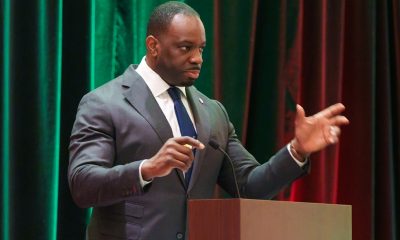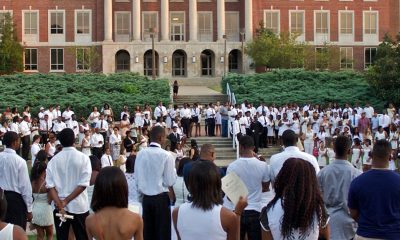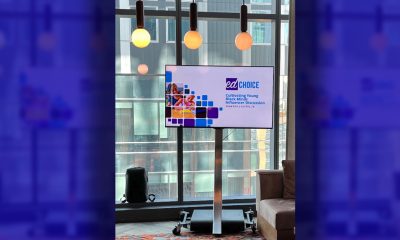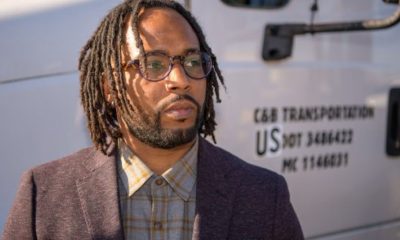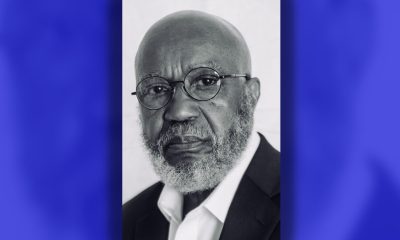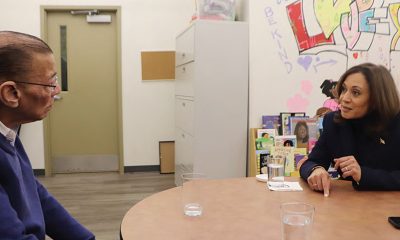Commentary
Equity v. Equality
NNPA ESSA AWARENESS CAMPAIGN — ESSA gives power back to the states to control education policy. Now, members of the community must hold their school leaders and elected officials accountable to implement system-wide and school-specific measures that ensure equity in our schools.
By: Naomi Shelton, Director of K-12 Advocacy at UNCF (United Negro College Fund)
Equity has been a huge buzzword in the field of education this year. Education advocates and politicians alike have called for an increase in educational equity, but what does the term really mean? Equity is not Equality. Equity creates equality by prioritizing resources to students who need them the most.
For example, think of a typical track meet. There are five runners – each in their own lane. Each runner must run one lap around the track. The first runner to complete the lap, wins the race. Now let’s use this analogy to inform our understanding of equity.
Equality would mean that every runner would start the race at the exact same spot in their lane. However, the track is oval-shaped. If each runner began at the same spot, each runner’s distance to the finish line would be different. The runner in the innermost lane would run a shorter distance than the runner in the outermost lane. Sure, they would both start in the same spot (EQUAL), but the runners in the innermost lanes would have an advantage – in distance – than their counterparts in the outermost lanes.
This is precisely why track meets do not operate this way. Since the track is oval-shaped, each runner begins the race in their own lane, at different, equal distance, spots along the track; ensuring that each runner, runs the exact same distance needed to complete the race.
Now, think of our current public education system in this same context. Students – regardless of race, geography, household makeup – start on the same marker on the track. Some students, like the runner in the outermost lane, have to run harder and faster to get to the finish line. The barrier here is distance. In the real world, barriers include low-income, resource deprived neighborhoods, disabilities that require additional expertise, culturally negligent curriculum, outdated technology, inexperienced teachers or access to critical supportive services.
Meanwhile, the runner in the innermost lane has it a lot easier. They don’t have to run as fast or as hard to get to the finish line because of their initial position in the race. The barriers here are fewer in number. In terms of education, these innermost runners attend schools in affluent neighborhoods with a surplus of resources. These students have the advantage of local tax-based funding formulas, parent lead fundraising efforts and/or private funding, and state-of-the-art technology.
What we need is education reform that promotes fairness. Fairness equals equity. As Debby Irving in her book Waking Up White: And Finding Myself in the Story of Race states, “Equality means giving all students the exact same thing to meet the same expectations. Equity means holding people of differing needs to a single expectation and giving them what they need to achieve it.” In other words, the playing fields need to be leveled. It’s critical that our public educational system undertakes reform – changes so that each student is given what they need to succeed.
Our education system should support students by allocating the most resources to students who are most in need, just as track athletes arrange themselves for fairer competition. The national education law, the Every Student Succeeds Act (ESSA) targets dollars to the highest poverty schools and districts.
Under No Child Left Behind, schools could lose funding if they failed to meet statewide standards. But under ESSA, states cannot reduce funding by more than ten percent from year to year despite school performance. ESSA also attempts to ensure that low-income students are not disproportionally taught by ineffective, inexperienced, and/or out-of-field teachers.
ESSA requires that state and district report cards include the percentage of inexperienced teachers, principals, and other school leaders as well as teachers with emergency credentials, and teachers teaching subjects out of their range of expertise. ESSA also seeks to relieve some teacher angst surrounding evaluation systems by ending the requirement for state teacher evaluation systems to focus significantly on student test scores.
ESSA gives power back to the states to control education policy. Now, members of the community must hold their school leaders and elected officials accountable to implement system-wide and school-specific measures that ensure equity in our schools.
Furthermore, UNCF’s 2017 community resource, Lift Every Voice and Lead Toolkit: A Community Leader’s Advocacy Resource for K-12 Education, offers step-by-step analysis of African American Education and highlights organizations that have effectively engaged in education efforts at a local level to support efforts in improving the quality of education for all students.
Naomi Shelton has experience in education related community engagement both at the national and local levels and public administration. Currently, she is the Director of K-12 Advocacy at UNCF (United Negro College Fund), the nation’s largest and most effective minority education organization. There, she focuses on national education initiatives and community engagement efforts to ensure more African-American students are college and career ready. Naomi is currently a member of the DC Public Charter School Board, appointed by Washington, D.C. Mayor, Muriel Bowser. Her passion is educational equity. Follow Naomi on Twitter at @NaomiSheltonDC
Commentary
Opinion: Lessons for Current Student Protesters From a San Francisco State Strike Veteran
How the nation’s first College of Ethnic studies came about, bringing together Latino, African American and Asian American disciplines may offer some clues as to how to ease the current turmoil on American college campuses over the Israel-Hamas war. After the deadline passed to end the Columbia University encampment by 2 p.m. Monday, student protesters blockaded and occupied Hamilton Hall in a symbolic move early Tuesday morning. Protesters did the same in 1968.

By Emil Guillermo
How the nation’s first College of Ethnic studies came about, bringing together Latino, African American and Asian American disciplines may offer some clues as to how to ease the current turmoil on American college campuses over the Israel-Hamas war.
After the deadline passed to end the Columbia University encampment by 2 p.m. Monday, student protesters blockaded and occupied Hamilton Hall in a symbolic move early Tuesday morning.
Protesters did the same in 1968.
That made me think of San Francisco State University, 1968.
The news was filled with call backs to practically every student protest in the past six decades as arrests mounted into hundreds on nearly two dozen campuses around the country.
In 1970, the protests at Kent State were over the Vietnam War. Ohio National Guardsmen came in, opened fire, and killed four students.
Less than two weeks later that year, civil rights activists outside a dormitory at Jackson State were confronted by armed police. Two African American students were killed, twelve injured.
But again, I didn’t hear anyone mention San Francisco State University, 1968.
That protest addressed all the issues of the day and more. The student strike at SFSU was against the Vietnam war.
That final goal was eventually achieved, but there was violence, sparked mostly by “outside agitators,” who were confronted by police.
“People used the term ‘off the pigs’ but it was more rally rhetoric than a call to action (to actually kill police),” said Daniel Phil Gonzales, who was one of the strikers in 1968.
Gonzales, known as the go-to resource among Filipino American scholars for decades, went on to teach at what was the positive outcome of the strike, San Francisco State University’s College of Ethnic Studies. It’s believed to be the first of its kind in the nation. Gonzales recently retired after more than 50 years as professor.
As for today’s protests, Gonzales is dismayed that the students have constantly dealt with charges of antisemitism.
“It stymies conversation and encourages further polarization and the possibility of violent confrontation,” he said. “You’re going to be labeled pro-Hamas or pro-terrorist.”
That’s happening now. But we forget we are dealing not with Hamas proxies. We are dealing with students.
Gonzales said that was a key lesson at SF State’s strike. The main coalition driving the strike was aided by self-policing from inside of the movement. “That’s very difficult to maintain. Once you start this kind of activity, you don’t know who’s going to join,” he said.
Gonzales believes that in the current situation, there is a patch of humanity, common ground, where one can be both pro-Palestine and pro-Israel. He said it’s made difficult if you stand against the belligerent policies of Benjamin Netanyahu. In that case, you’re likely to be labeled antisemitic.
Despite that, Gonzales is in solidarity with the protesters and the people of Gaza, generally. Not Hamas. And he sees how most of the young people protesting are in shock at what he called the “duration of the absolute inhumane kind of persecution and prosecution of the Palestinians carried out by the Israeli government.”
As a survivor of campus protest decades ago, Gonzales offered some advice to the student protesters of 2024.
“You have to have a definable goal, but right now the path to that goal is unclear,” he said.
About the Author
Emil Guillermo is a journalist and commentator. A veteran newsman in TV and print, he is a former host of NPR’s “All Things Considered.”
Activism
Oakland Post: Week of May 1 – 7, 2024
The printed Weekly Edition of the Oakland Post: Week of May 1 – 7, 2024

To enlarge your view of this issue, use the slider, magnifying glass icon or full page icon in the lower right corner of the browser window. ![]()
Activism
Oakland Post: Week of April 24 – 30, 2024
The printed Weekly Edition of the Oakland Post: Week of April 24 – 30, 2024

To enlarge your view of this issue, use the slider, magnifying glass icon or full page icon in the lower right corner of the browser window. ![]()
-

 Community3 weeks ago
Community3 weeks agoFinancial Assistance Bill for Descendants of Enslaved Persons to Help Them Purchase, Own, or Maintain a Home
-

 Business3 weeks ago
Business3 weeks agoV.P. Kamala Harris: Americans With Criminal Records Will Soon Be Eligible for SBA Loans
-

 Activism4 weeks ago
Activism4 weeks agoOakland Post: Week of April 10 – 16, 2024
-

 Community3 weeks ago
Community3 weeks agoAG Bonta Says Oakland School Leaders Should Comply with State Laws to Avoid ‘Disparate Harm’ When Closing or Merging Schools
-

 Activism2 weeks ago
Activism2 weeks agoOakland Post: Week of April 24 – 30, 2024
-

 Community2 weeks ago
Community2 weeks agoRichmond Nonprofit Helps Ex-Felons Get Back on Their Feet
-

 Community2 weeks ago
Community2 weeks agoOakland WNBA Player to be Inducted Into Hall of Fame
-

 Community2 weeks ago
Community2 weeks agoRPAL to Rename Technology Center for Retired Police Captain Arthur Lee Johnson

